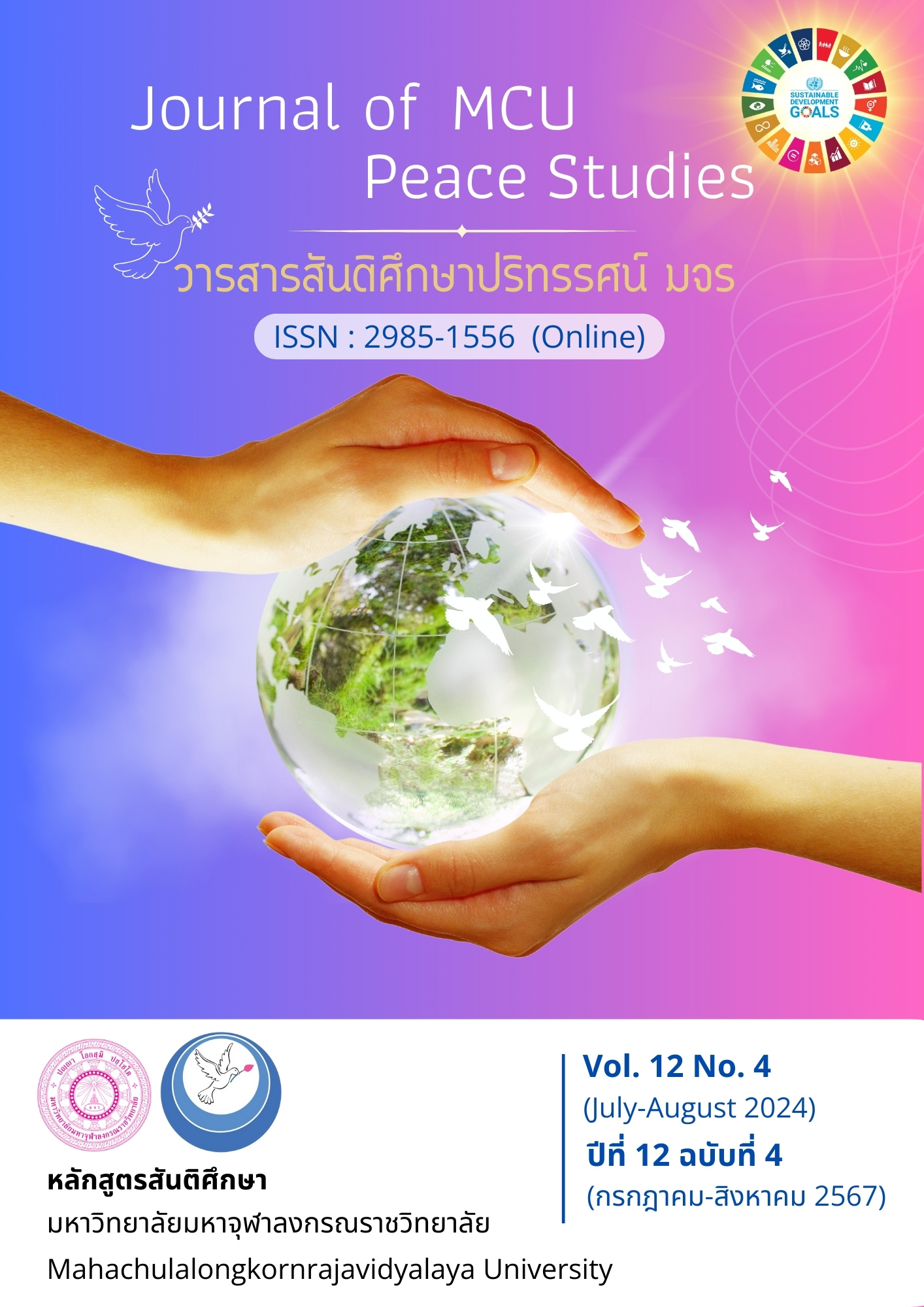การพัฒนาการคิดวิเคราะห์และผลสัมฤทธิ์ทางการเรียนของนักเรียน ชั้นมัธยมศึกษาปีที่ 4 หน่วย งานและพลังงาน โดยการจัดการเรียนรู้เทคนิค STAD ร่วมกับผังกราฟิก
Main Article Content
บทคัดย่อ
การวิจัยครั้งนี้มีวัตถุประสงค์เพื่อ 1) พัฒนาและหาประสิทธิภาพของแผนการจัดการเรียนรู้เทคนิค STAD ร่วมกับผังกราฟิก หน่วย งานและพลังงาน ของนักเรียนชั้นมัธยมศึกษาปีที่ 4 มีประสิทธิภาพตามเกณฑ์ 80/80 2) ศึกษาและเปรียบเทียบการคิดวิเคราะห์ของนักเรียนก่อนเรียนและหลังเรียน 3) เปรียบเทียบผลสัมฤทธิ์ทางการเรียนของนักเรียนก่อนเรียนและหลังเรียน และ 4) ศึกษาความพึงพอใจของนักเรียนที่มีต่อการจัดการเรียนรู้เทคนิค STAD ร่วมกับผังกราฟิก การวิจัยในครั้งนี้เป็นการวิจัยเชิงทดลอง โดยมีกลุ่มตัวอย่าง คือ นักเรียนชั้นมัธยมศึกษาปีที่ 4 โรงเรียนบัวขาว สังกัดองค์การบริหารส่วนจังหวัดกาฬสินธุ์ ภาคเรียนที่ 2 ปีการศึกษา 2565 จำนวน 40 คน ได้มาจากการสุ่มแบบกลุ่ม เครื่องมือที่ใช้ในการวิจัย ได้แก่ 1) แผนการจัดการเรียนรู้เทคนิค STAD ร่วมกับผังกราฟิก 2) แบบทดสอบวัดการคิดวิเคราะห์ 3) แบบทดสอบวัดผลสัมฤทธิ์ทางการเรียน และ 4) แบบสอบถามความพึงพอใจ สถิติที่ใช้ในการวิเคราะห์ข้อมูล ได้แก่ ค่าร้อยละ ค่าเฉลี่ย ส่วนเบี่ยงเบนมาตรฐาน และสถิติทดสอบค่าทีแบบไม่เป็นอิสระต่อกัน
ผลการวิจัยพบว่า 1) แผนการจัดการเรียนรู้เทคนิค STAD ร่วมกับผังกราฟิก ของนักเรียนชั้นมัธยมศึกษาปีที่ 4 มีประสิทธิภาพเท่ากับ 80.87/80.92 สูงกว่าเกณฑ์ 80/80 ที่กำหนดไว้ 2) การเรียนรู้เทคนิค STAD ร่วมกับ ผังกราฟิก ผู้เรียนได้ทำกิจกรรมร่วมกันเป็นกลุ่มทำให้ผู้เรียนแลกเปลี่ยนเรียนรู้ ช่วยเหลือกัน และส่งเสริมให้ผู้เรียนมีการคิดวิเคราะห์ ซึ่งก่อนเรียนมีคะแนนเฉลี่ยร้อยละ 29.83 และหลังเรียนมีคะแนนเฉลี่ยร้อยละ 81.25 เมื่อเปรียบเทียบคะแนนเฉลี่ยหลังเรียนสูงกว่าก่อนเรียนอย่างมีนัยสำคัญทางสถิติที่ระดับ .01 3) ผู้เรียน มีผลสัมฤทธิ์ทางการเรียน โดยการจัดการเรียนรู้เทคนิค STAD ร่วมกับผังกราฟิก หลังเรียนสูงกว่าก่อนเรียนอย่างมีนัยสำคัญทางสถิติที่ระดับ .01 และ 4) ความพึงพอใจของนักเรียนที่มีต่อการจัดการเรียนรู้เทคนิค STAD ร่วมกับผังกราฟิก อยู่ในระดับมากที่สุด ( = 4.65, S.D. = 0.49)
Article Details

อนุญาตภายใต้เงื่อนไข Creative Commons Attribution-NonCommercial-NoDerivatives 4.0 International License.
ทัศนะและความคิดเห็นที่ปรากฏในบทความในวารสาร ถือเป็นความรับผิดชอบของผู้เขียนบทความนั้น และไม่ถือเป็นทัศนะและความรับผิดชอบของกองบรรณาธิการ ยินยอมว่าบทความเป็นลิขสิทธิ์ของวารสาร
เอกสารอ้างอิง
Bloom, B.S. (1956). Taxonomy of Education Objective, Handbook 1: Cognitive Domain. New York: David Mckay.
Eiamsukmingkol, E., Jaradrawiwat, S., & Singlop, S. (2020). Effects of the Inquiry Cycle (5Es) Learning Method with the Student Teams Achievement Division on the Topic of the Function of Human and Animal Body System Toward Learning Achievement and Analytical Thinking Abilities of Mathayomsuksa 2 Students. Journal of Graduate School Sakon Nakhon Rajabhat University, 17(77), 113-123.
Jampa, K., Jaiboon, P., & Pansuppawat, A. (2019). The Development of Science Process Skills on Current Electricity through Cooperative Learning STAD Technique Integrated with Graphic Organizers for Mattayomsuksa Five Students. Journal of Graduate School Sakon Nakhon Rajabhat University, 16(74), 40-49.
Kittiwutikrai, K., & Sitti, S. (2021). The Development of 2nd Grade Students’ Analytical Thinking Ability and Learning Achievement in the Science Subject of “The Materials Around Us” through the STAD Cooperative Learning Technique. Journal of Roi Kaensarn Academi, 6(7), 262-263.
Konklong, N., Tientongdee, S., Lee, A., & Ratniyom, J. (2019). Effects of STAD–Cooperative Learning Method on Grade 7 Students’ Science Learning Achievement and Problem-Solving Abilitiesin the Unit of Substances in Daily Life. Journal of Research Unit on Science, Technology and Environment for Learning, 10(1), 66-78.
McMillan, J. H., & Schumacher, S. (1997). Research in Education. New York: Longman.
Nakphong, P., Vanichwatanavorachai, S., Ramsiri, R., & Pongsakornnaruwong, M. (2021). The Development of Analytical Thinking Skill of Seventh Grade Students by Using Problem Based Learning and STAD Technique. (Master’ s Thesis). Silpakorn University. Nakhon Pathom.
National Institute of Educational Testing Service. (2020). Educational Test Report Basic National Level (O-NET), Mattayomsuksa 6, Academic Year 2020. Retrieved July 13, 2021, from http://www.newonetresult.niets.or.th/AnnouncementWeb/Login.aspx
Office of the Basic Education Commission. (2017). Measuring Indicators and Learning Content Core Science Learning Group (Revised Edition A.D. 2017) according to the Basic Education Core Curriculum, A.D. 2008. Bangkok: Agricultural Cooperative Assembly Printing House of Thailand Printing Co., Ltd.
Office of the Education Council. (2017). Thailand Education Scheme in Brief 2017-2036. Bangkok: Prighwan Graphic. Co., Ltd.
Prompan, W., Khamhaengpo, A., & Pansuppawat, T. (2020). Comparisons of Analytical Thinking Skills of Mathayomsuksa 6 Students on the Topic of Polymer Using the Learning Management Based on STAD Cooperative Learning with POE Technique and Conventional Instruction Approach. Journal of Humanities and Social Sciences Nakhon Phanom University, 10(2), 107-108.
Srisod, P. (2016) Provision of Learning Activities Focusing on Inductive Method to Develop Analytical Thinking Skills of Grade 11 Students. (Master’s Thesis). Chiang Mai University. Chiang Mai.
Sriwanna, K., & Pabchanda, S. (2021). The Development of Analytical Thinking Skill and Scientific Minds in Chemistry of Tenth Grade Student by Constructivist and Collaborative Learning. Journal of Education Khon Kaen University, 44(2), 97-109.
Suriwong, N., & Sungthong, A. (2020). Study on Achievement Test of Physics Subject on Light, and Visual Aids of Grade 11 Students under Learning Activity Organizing with STAD Cooperative Group. Journal of Science and Science Education, 3(1), 84-97.


